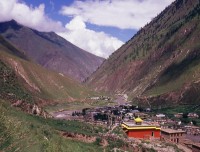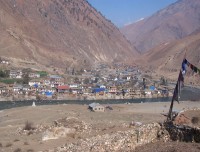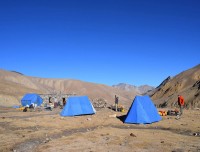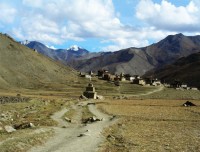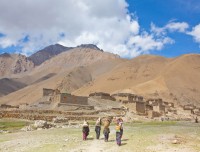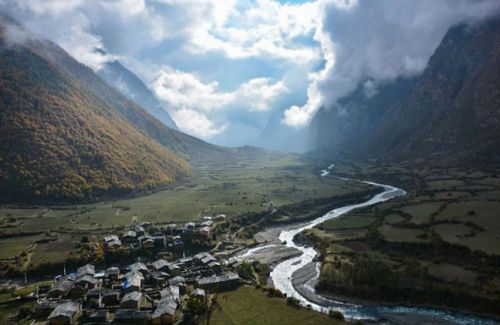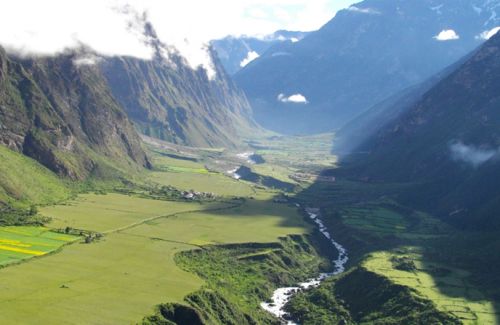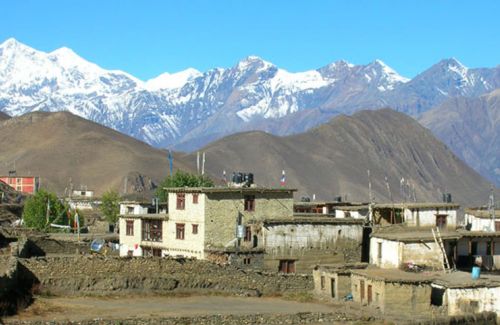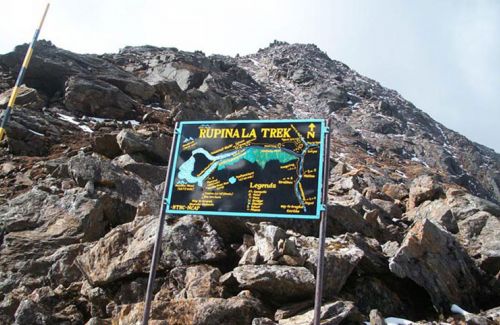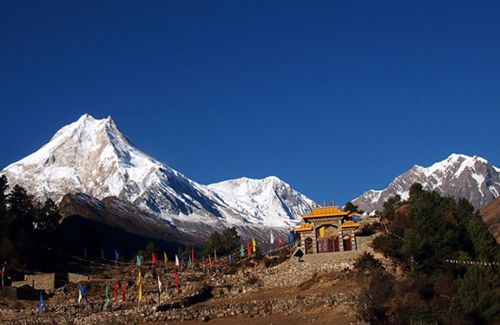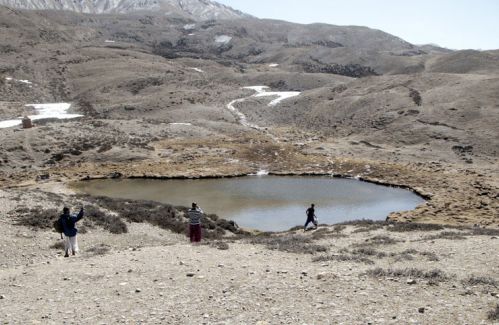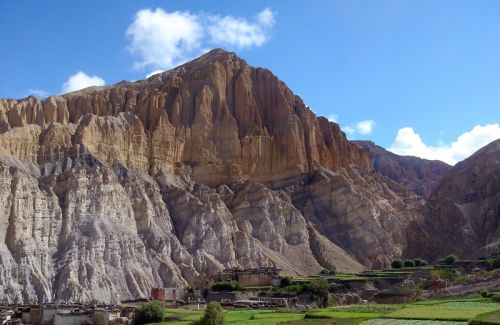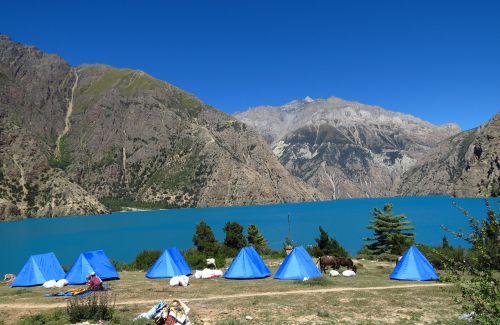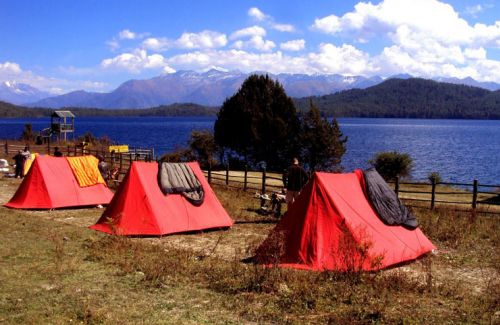Upper Dolpo Trekking
- Duration24 Days
- Max. Altitude5,151 m
- Starts FromUSD 2480
Destination:Nepal
Trip Grade:Strenuous (****)
Meals:Breakfast + Lunch + Dinner
Transportation:Private Vehicle / Aeroplane
Accommodation:Camping
Trip Route:Kathmandu – Nepalgunj – Phoksundo Lake – Kang La – Saldang La – Jeng La Pass – Tarakot – Juphal - Kathmandu
Show All
Upper Dolpo Trekking is to understand high altitude dwellers in the world, their way of life, culture and behold the miraculous landscape. Upper Dolpo Region is the outlying, the least developed region in Nepal. It is situated in the western part of Nepal. Trekkers were not permitted till 1989.The books written by Peter Matheson-"The snow Leopard and Snell Grove", "Himalayan Pilgrimage" have contributed a lot to know the amazing mystique realities of Dolpo where centuries old Buddhist and Bon Po traditions, interwoven with shamanistic influences. The landscapes are more desolate and the villagers are even more isolated and pure.
Dolpo is located in between Tibetan Plateau and Dhaulagiri range. Uper Dolpo trek is quite strenuous trek. We have to cross three high passes like: Nagdalo La (5,350 m), Shey La (5,000 m) and Jeng La (5,110 m). These passes are of long hiking up and descending down. Upper Dolpo is a restricted area. US $ 500 is charged for the first 10 days, and US $ 50 for each additional day. Currently, the maximum number of people who can enter in this region is 250. So, the trek Upper Dolpo is very special and of great experience.
Trek Upper Dolpo has been famous for the largest Shey Phoksundo National Park since 1984. The park has occupied 3,500 square kilometers of land, mostly above 4,000 m. There are many wild animals like Musk Deer, Himalayan Blue Sheep, and Snow Leopard. The people of Dolpo have very hard life and they are traders, exchanging barley for Tibetan rock salt. They take their yaks on to the Tibetan plateau during the summer time for grazing.The movie “Caravan”, directed by Eric Vally was filmed in this region and was nominated for Oscar award. Dolpo is one of the most beautiful treks in remote part of Nepal, very rarely visited by outsider.
Trip Highlights
- City tour at historical monuments in Kathmandu
- Explore the divine mountain kingdom at the foot of mighty Himalayas
- The biggest, beautiful, glistening lake- Shey Phoksundo Lake
- Witnessing the amazing ethnic culture
- Fully supported camping trek.
- Trekking through the biggest National Park of Nepal.
- Crossing over Kangla Pass (5151 m) Saldang Pass (4785 m)
Day to Day Itinerary
Day 01:Arrival in Kathmandu (1350 m), and Transfer to the Hotel. Overnight at Hotel
Day 02:Pre-trip Meeting and Sightseeing around Kathmandu valley & trek preparation. Overnight at Hotel
Day 03:Fly from Kathmandu to Nepalgunj. About 1 hour. Overnight at Hotel
Day 04:Fly to Juphal (2400 m). About 40 min and trek to Dunai (2150 m). 3 hrs, Overnight at Hotel
Day 05:Trek from Dunai to Ankhe (2660 m). About 6 hours. Overnight at Tented Camp
Day 06:Trek from Ankhe to Renje (3104 m). About 7 hours. Overnight at Tented Camp
Day 07:Trek from Renje to Shey-Phoksundo Lake (3600 m). About 7 hours. Overnight at Tented Camp
Day 08:Trek from Shey – Phoksundo Lake to Phoksundo Khola (3507 m). 6 hrs, Overnight at tented Camp
Day 09:Trek from Shey – Phoksundo Khola to Phoksundo Bhanjyang (4402 m).7 hrs, at tented Camp
Day 10:Trek from Phoksundo Bhanjyang to Shey Gompa (4085 m) via Kangla Pass (5151 m).7 hrs, At Camp
Day 11:Exploring Shey Gompa- the Buddhist Monastery. Overnight at Tented Camp
Day 12:Trek from Shey Gompa to Namduna Gaun (4400 m) via Saladanga La Pass (4785 m).Camp
Day 13:Trek from Namduna Gaun to Saldang (4151 m). About 4 hrs, Overnight at Tented Camp
Day 14:Trek from Saldang to Sibu (3942 m). About 6 hrs, Overnight at Tented Camp
Day 15:Trek from Sibu to Jengla (4369 m). About 6 hrs, Overnight at Tented Camp
Day 16:Trek from Jengla to Tokyu Gaun (4240 m) via Jengla Pass (4845 m). 7 hrs, At Tented Camp
Day 17:Trek from Tokyu Gaun to Dhotarap (3586 m). About 5 hrs, Overnight at Tented Camp
Day 18:Trek from Dhotarap to Serkam (3630 m). About 6 hrs, Overnight at Tented Camp
Day 19:Trek from Serkam to Khanigaun (2550 m). About 7 hrs, Overnight at Tented Camp
Day 20:Trek from Khanigaun to Tarakot (2281 m). About 4 hrs, Overnight at Tented Camp
Day 21:Trek from Tarakot to Dunai (2052 m). About 5 hrs, Overnight at Tented Camp
Day 22:Trek from Dunai to Jufal (2404 m). About 3 hrs, Overnight at Tented Camp
Day 23:Fly back from Juphal to Nepaljung and to Kathmandu. Overnight at hotel
Day 24:Departure to the International Airport
Cost Include
- Airport picks up & drops by private tourist vehicle
- A Guided city tour by private tourist vehicle
- A government licensed holder city tour guide
- Fly from Kathmandu to Nepalgunj and Nepalgunj to Juphal
- Fly back from Juphal to Nepalgunj and Nepalgunj to Kathmandu
- 3 nights twin sharing 2-3 star hotel in Kathmandu with Breakfast
- Guided city tour in Kathmandu by private tourist vehicle
- Full Board Meals (Breakfast + Lunch + Dinner) during the trek
- Tented Camp accommodation during the trek
- Professional license holder English speaking Trekking Guide
- The required number of local staff and porters (2 Trekkers = 1 Porter)
- Food, accommodation, salary, insurance, equipment and medicine for all staff
- Upper Dolpo Special Permit and TIMS permit for the trekking
- All required Tented Camp equipments
- Down Jacket, Duffle bag and sleeping bag by Himkala Adventure if required
- Farewell dinner in traditional Nepali Restaurant with typical Nepali Cultural Show
-
Government taxes, vat & service charges
Cost Exclude
- Lunch and dinner whilst in Kathmandu & Nepaljung.
- Entrance fees in all Heritage Sites during tour
- Emergency Rescue and Evacuation cost
- Your travel insurance
- Nepal entry visa fee
- Personal trekking Equipment
- Tips for trekking, tour staff and driver (Tipping is expected)
- Drinks- alcoholic, non alcoholic - hot and cold drinks
- Other Personal Expenses like phone bills, laundry etc
- Any others expenses which are not mentioned on ‘Cost Includes' section
Detail Itinerary
Day 01Arrival in Kathmandu (1350 m), and Transfer to the Hotel. Overnight at HotelOur representative from Himkala Adventure greets you at the Tribhuvan International Airport and transfers you to the hotel. You could take rest or walk around Thamel in your leisure time. Overnight in Kathmandu
Day 02Pre-trip Meeting and Sightseeing around Kathmandu valley & trek preparation. Overnight at Hotel After breakfast, we set out for the guided city sightseeing to the historical monument sites which are listed in UNESCO World Heritage Sites. We will visit, Stupa, monasteries, gompas, temples in different architectures, palaces, courtyards museums. It is the golden opportunities to be in Nepal to see the ritual activities of different ethnic groups lively. After the day tour, we return back to hotel and give you briefing about the Upper Dolpo Trekking. Overnight in Kathmandu
Day 03Fly from Kathmandu to Nepalgunj. About 1 hour. Overnight at Hotel We drive from our hotel to the domestic terminal at Tribhuvan International Airport and fly to Nepalgunj. It is 45 minutes flight with great landscape view to Nepalgunj view. After our arrival at Nepalgunj, our will be transferred to the hotel. Overnight in Nepalgunj
Day 04Fly to Juphal (2400 m). About 40 min and trek to Dunai (2150 m). 3 hrs, Overnight at Hotel Today, we fly from Nepalgunj to Juphal in the morning. It is 35 minutes flight from Nepalgunj. Then, we begin our trek from Juphal to Dunai. It is about 3 hour’s trek passing wonderful landscapes through terraced farm lands following the Bheri River and the gorge. Overnight at Dunai
Day 05Trek from Dunai to Ankhe (2660 m). About 6 hours. Overnight at Tented Camp After breakfast, we cross the new suspension bridge and turn to the west. We follow the same path and pass the hospital. There is a confluence of the Thuli Bheri and the Suli Gad. We turn to the north following the Suli Gad. We continue the trail going up and pass the villages. We can see the villagers growing the plants called ‘Chuk’, is being used preparing vinegar and medicines. We arrive at Hanke, the village, continuing the track. There are three villages named Parela, Rahagaon and Ankhe meaning eyelash, eyebrow and eye respectively. Finally, we reach to Ankhe and stay overnight there. Overnight at Ankhe
Day 06Trek from Ankhe to Renje (3104 m). About 7 hours. Overnight at Tented Camp After breakfast, we set out our journey to Renje after crossing the river twice then climb to the narrow path. We descend to the river and climb up again to reach Renje following the Suli Gad river. Overnight at Renje
Day 07Trek from Renje to Shey-Phoksundo Lake (3600 m). About 7 hours. Overnight at Tented Camp After breakfast, we have an easy trek to Sumdo but after this, we have to climb steep leaving the River behind. We hit the ridge at an elevation of 3,875 m and see the soothing view of 300 m long waterfall. We descend passing through the birch forest and arrive at Phoksundo Khola and after a while head towards Ringmo with chortens and Mani walls.From Ringmo village, it is a short walk to Phoksundo Lake. Overnight at Phoksundo Lake
Day 08Trek from Shey – Phoksundo Lake to Phoksundo Khola (3507 m). 6 hrs, Overnight at tented Camp Today, we walk around the lake and ascend steeply up to 4,040 m high from the sea level. Reaching on this top, we view all around and plummet to the Phoksundo Khola. We follow the riverside along with the forest on the bottom of the valley. Overnight at Phoksundo Khola
Day 09Trek from Shey – Phoksundo Khola to Phoksundo Bhanjyang (4402 m).7 hrs, at tented Camp After having breakfast, we cross the stream and continue through a glacial lake and head towards north. The craggy cliff and unimaginative rock formations bewilders everyone. We cross the bridge over the confluence of Phoksundo Khola and another stream, we head towards north east up a side valley. After a long climb, we arrive at the meadow where the trail goes around the steep gorge. We cautiously climb this steep way up to the top from where we can see the amazing view of Kang La. The trail leads us to Shey Gompa. Overnight at Phoksundo Bhanjyang
Day 10Trek from Phoksundo Bhanjyang to Shey Gompa (4085 m) via Kangla Pass (5151 m).7 hrs, At Camp After breakfast, we trek about 3 hours to reach the top of the Kang La at an elevation of 5,151 m. After getting magnificent view from the top, we descend steeply down to the valley floor along the bank of the river. After we cross the bridge, we can see the red chorten at Shey Gompa. Overnight at Shey Gompa
Day 11Exploring Shey Gompa- the Buddhist Monastery. Overnight at Tented Camp Today’s rest at Shey Gompa is worth mentioning for acclimatization and exploration around it. The Shey gompa belongs to Chaiba community, the followers of the Padmashambhava and Kagyu sects. This is the 11th Century old monastery founded by Ten-szin Ra-Pa. Shey Gomba is situated in the confluence of Kangjunala and Yejunala. We can see the prayer wheels spun by water. Overnight at Shey Gompa
Day 12Trek from Shey Gompa to Namduna Gaun (4400 m) via Saladanga La Pass (4785 m).Camp After breakfast, we follow the trail through juniper forest and ascend to the grey, stony canyon. After this, the trail fluctuates and reaches to the flat. We continue to the steep ascend until we reach to Saldang La Pass which takes about 20 minutes from the plain land. It is the nice place to view the amazing landscape of Mustang and snowy peaks of Tibet. From the top of Saldang La Pass, we drop down to Namduna Gaon passing pastureland and nomadic shelters. The monastery belongs to Karma-pa sect – Namgung is famous in its architecture with red and white colors against the backdrop of a cliff on the north wall of the gorge. There are only 6 houses and the people are relying on agricultural products like barly, animal husbandry and trading. There is a newly built monastery too. Overnight at Namduna Gaun
Day 13Trek from Namduna Gaun to Saldang (4151 m). About 4 hrs, Overnight at Tented Camp After leaving Namduna village, we climb to the rough mountain. We continue climbing before we start descending to the beautiful village of Saldang which is located on a plateau high above the NamKhong Nala and the biggest village of inner Dolpo. Saldang lies in the arid zone of the trans-Himalayan Tibetan plateau. This village has covered around 2 km slopes with 5 different villages. There are 80 houses and about 600 residents. This is the prosperous place based on agriculture and trading route to Tibet. Overnight at Saldang
Day 14Trek from Saldang to Sibu (3942 m). About 6 hrs, Overnight at Tented Camp After having breakfast, we begin to trek to Sibu. We descend down to the river bed passing through the terraced fields, stupas, chortens, mani stones. From here, we arrive at Namdo Village, stretched more than 5 km on the slopes. There is Namdo monastery situated near the river bed. Eventually we reach to Sibu on the river bank for the overnight stay. Overnight at Sibu
Day 15Trek from Sibu to Jengla (4369 m). About 6 hrs, Overnight at Tented Camp We continue the river valley, after 2 hours walk, we cross the stream before we go through the valley it is quite sharp ascend. The walk on the meadow is pleasant. Overnight at Jengla
Day 16Trek from Jengla to Tokyu Gaun (4240 m) via Jengla Pass (4845 m). 7 hrs, At Tented Camp Today, we climb steeply about 2 hours to reach to the top of Jeng La. We can see Dhaulagiri from the top. Then, we descend down to the Tarap valley. After following the green valley, we further come down to Tarao Chu. This is another well furnished village extended 20 km along the river which has 10 villages with many gompas, chortens. We stay in Tokyu Monastery for the overnight stay. This belongs to Chaiba sect. Overnight at Tokyu
Day 17Trek from Tokyu Gaun to Dhotarap (3586 m). About 5 hrs, Overnight at Tented Camp We can visit Chaiba Gompa. It is the flat, well made trail to Dho Tarap. We encounter the yak herder and caravan of yaks on the way. We can see the people working in the field. There is the French School outside the village of Dho Tarap. The inhabitants follow duo Bon Po and Buddhism. We can visit the Bon Gompa after half an hour walk from the place we stay. Overnight at Dho Tarap
Day 18Trek from Dhotarap to Serkam (3630 m). About 6 hrs, Overnight at Tented Camp After breakfast, we follow the Tarap Khola going downhill. We pass the narrow gorge. We can see the blue sheep and the people with their flock of sheep descending to the lower pastureland. After this, we find the trail improving. Finally we arrive at Serkam. Overnight at Serkam
Day 19Trek from Serkam to Khanigaun (2550 m). About 7 hrs, Overnight at Tented Camp We descend down to the gorge of the Tarap River through the narrow trail from the steep slopes. The day is more adventurous passing deep and exciting gorges. But we come to pleasant meadow passing rough, crumbly narrow path and enjoy the overnight stay at Khanigaun. Overnight at Khanigaun
Day 20Trek from Khanigaun to Tarakot (2281 m). About 4 hrs, Overnight at Tented Camp After breakfast, we cross the new suspension bridge and walk along the river. The path goes sometimes high and low. We arrive at the fertile valley of Barbung Chu and pass through the cultivable land. Tarakot has an old fortress built by the local people known as Dzong. There is Sandul Gompa, 8 km ar from Tarakot, situated on the confluence of Barbung Khola and Tarap Chu. Overnight at Tarakot
Day 21Trek from Tarakot to Dunai (2052 m). About 5 hrs, Overnight at Tented Camp After breakfast, we descend down along the Bheri River. The trail has been built about 20 feet high above the river. After arrival at Dunai, we can visit the local market and the people there. This is the completion of Upper Dolpo Circuit. Overnight at Dunai
Day 22Trek from Dunai to Jufal (2404 m). About 3 hrs, Overnight at Tented Camp From Dunai, we retrace back to Juphal which takes 3 hours. This is the flat, easy walk but finally it is steep ascend to Juphal Overnight at Juphal
Day 23Fly back from Juphal to Nepaljung and to Kathmandu. Overnight at hotel This is 35 minutes’ early morning flight back to Nepalgunj. This scenic flight offers the grand mountain view of Annapurna Massifs and the Dhaulagiri to the north. Then, after our arrival at Nepalgunj, we connect with the other flight back to Kathmandu. We drive to hotel from Tribhuvan airport. Overnight at Kathmandu
Day 24Departure to the International Airport Your trip to wonderful place to Upper Dolpo ends today! We escort you to the Tribhuvan International Airport 3 hours before your scheduled flight. We would like to show our gratitude that you joined Himkala Adventure for unique destination to Upper Dolpo and depart from the airport. We wish you to have safe journey back to sweet home. Namaste!!!
Trip FAQ
Himkala Adventure would like to quench the thirst of all necessary questions answers about Upper Dolpo Trekking for all curious travelers/trekkers in the world. As you are entirely from different geographical location, you could better to know everything about the treks from the beginning i.e. airport pick up till your departure like airport picks up, drops off, accommodation in city, in the trek, guide and porters, safety for the trekking, food and accommodation and some other things that you might face on the way. Hope our endeavor listing these questions answers will help you self informed.
This is simply the outlines of the services we offer but it may differ as per your requirement, number of trekkers. What we go through our conversation, we will manage the means of transportation, hotels in the city, accommodation in the trekking, numbers of porters etc. This is general idea about Upper Dolpo Trekking before your trip and you become clearer about the trek. Please feel free to contact us to get more information about the trekking in the Himalayas of Nepal.
1) How is Upper Dolpo Trekking in Nepal?
The Upper Dolpo region is a very isolated area which has been strictly off-limits so the traditions and way of life have remained intact. Upper Dolpo trekking route passes through many gigantic mountain ranges - Annapurna , Dhaulagiri and Kanjiroba, to name but a few - and passed through Lower Dolpo.It is the trekking of the mysterious land.
2) What physical fitness do I need to book this trip?
Every trekking in the Himalayas of Nepal require the certain level of physical and mental fitness.So, we advise you to be in good physical shape and able to feel comfortable while hiking up and down 7 to 12 miles per day on a trail carrying a day pack of about 10 pounds. Three things could make you confident enough for any trek you would like to do: aerobic, strength and mental.
Aerobic conditioning is important primarily because you will be trekking in thinner air, up to 40% less than at sea level. With good aerobic conditioning, you will be able to better metabolize whatever oxygen is available to you. You should plan on doing at least one hour of aerobic 3 /4 times per week for 1 month or more before your arrival in Nepal. Walking, jogging, cycling, hiking on valley floor to ridge line ascents with day back are some of the excellent forms of exercise, so long as you are strengthening leg muscles and building stamina. Speed is not the essence; stamina, confidence and continuity are.
3) How do I find Himkala Adventure for my pick up at the airport?
Our representative from Himkala Adventure will display a small board of company or with your name outside the airport terminal. You will be driven to the hotel by our tourist vehicle.
4) What sort of accommodation do I get in Kathmandu?
Normally we provide standard rooms with twin sharing accommodations at three star or similar category hotels in Kathmandu including breakfast. Accommodation in these cities can be upgraded as per your request. But some of our packages are sold without accommodation in the city.
5) How is camping trek during Upper Dolpo Trekking?
Camping trek to Upper Dolpo is fully organized and supported, with a team of guides, cooks, and porters to accompany you. Our porters carry all the trekking gear, food, fuel and personal belongings. Our cooks prepare hot meals. Trekkers need only carry a small bag as required for the day. At night, tents for dining, sleeping and ablutions tents are provided and set up, also mattresses and down-filled sleeping bags, tables and seating.
In a typical camping trek, we start the day around 6 a.m. with a cup of hot tea. You are then provided with a bowl of warm water for washing. Then trekkers enjoy breakfast before leaving camp. The trek begins around 7.30 - 8 a.m.Trekkers can set their pace for pausing and sightseeing and the walk to the lunch spot will normally take 3 hours. On arrival, you are served hot lunch. In the afternoon, after walking for another 3 to 4 hours, you arrive at the next camp around 5 p.m. Tea & snacks are served while our staff readies the camp. Dinner time is around 6/7 p.m. in the dining tent, lit with lanterns and comfortably furnished. The food is healthy, wholesome and hygienically prepared.
6) What mode of transportation do I use?
We will provide the private transportation for Airport/Hotel/Airport pick up and drop and sightseeing in Kathmandu Valley. We use transportation as based on our cost inclusion section. The transportation varies depending on your requirements at the time of booking the trip.
7) What is the best season for this trekking?
The best season for Upper Dolpo Trekking is spring (March to May) and autumn (September to December). These are the perfect time of the year for the breathtaking views of Himalayas with clear and sunny days. But the weather in the mountains is unpredictable.
8) What is the weather and temperature like during the trekking?
The climate in Nepal varies from place to place which can be categorized in different four main seasons. The main seasons in Nepal are spring (March to May), summer (June to August), autumn (September to November) & winter (December to February). The best season to travel in Nepal is autumn (September, October & November) & spring (March, April & May). Weather in the mountains is unpredictable. But the day temperature in Upper Dolpo Trekking is comfortable.
9) Who will be guiding me during this trip?
We provide the professional government license holder English speaking trekking guides for our entire trekking trip. We can also provide French, Spanish, Japanese, German or Italian speaking guides as per your preference with extra payment but not guaranteed. All guides will be Nepali people who are carefully selected on the basis of their appropriate experience, leadership skills and personality. They are all trained from Nepal Academy of Tourism and Hotel Management, certified and approved by the Tourism Department of Nepal government. We provide a different city tour guide to guide you in UNESCO World Heritage Sites in Kathmandu. They are the professional license holder guide specialized in culture, history, geography, iconography, archeology and religion with good command over English. Tour guides are specialized in city tour and trekking guides are more in the hiking and trekking in the Himalayas.
10) What sort of experience do your guides have?
Our entire city tour guides have bachelors to Master Degree academic education along with many months tour guiding training from Nepal Academy of Tourism and Hotel Management, Rabi Bhawan, Kathmandu, Nepal. They are fluent in spoken languages and informative about the sites in many aspects. They are quite experienced and dedicated to their job and responsibilities.
Our entire trekking guides have minimum Intermediate to Master Degree academic education with trekking guide training from Nepal Academy of Tourism and Hotel Management, Rabi Bhawan, Kathmandu, Nepal. Many of them are from villages. As they are local, they know more about the routes, necessary precaution to be taken and so on. They have spent many years exploring many parts of the country. They are trained in first aid and able to handle any situation easily. They speak good English and make you know about the places you visit.
11) May I charge my electronic devices during Upper Dolpo Trekking?
This is fully camping trek, so we may not be nearby any settlements. You could better manange extra battery or any other alternatives.
12) What is the social and environmental responsibility of Himkala Adventure for this trip?
The situation of environment in Nepal is in considerable stage due to so many factors caused by global warming, human activities, and adverse effects of natural incidents. Nepal is in between two giant countries like China and Nepal. The ozone layer is depleting and the atmosphere is getting heated. So, its direct effect is to the Himalayas that the snow is melting day by day and the sea level is rising. It is due to population growth, people are clearing the forest and the soil is being eroded. As a part of society, and our trekking related activities are directly concerned with the social and environmental things. We are very conscious not litter in the open spaces, to manage garbage properly and make local people aware in this campaign. We are working together with other companies and taking these issues seriously.
13) What is the minimum number requirement for this trip?
We operate individual trip to the group joining trips for Upper Dolpo Trekking. If you want to do any private trip we are ready to organize for solo traveler as well with some additional charges.
14) Are there communication or internet services during Upper Dolpo Trekking?
We highly recommend taking local SIM card for call and internet services during trekking. Local SIM cards are easily available in many stores and at airport as well. You need to provide two copies of your photographs and your passport copy to get local SIM CARDS of NCELL & NTC (only these two companies provide telephone services in Nepal
15) May I add extra days in trekking?
We are ready to operate your holidays as per your interest and requirements. You can spend extra days on your loving or favorable places or even can make it shorter. We will always do our best to manage your hotel bookings, flight booking and everything.
16) What happens in case of emergency?
Himkala Adventure has prepared for any emergency situation and knows how to handle it. Our guides are trained in first aid and can deal with most of the basic ailments that occur during the trek. Every client should have his own insurance before coming to Nepal for the case of emergency.
17) Do I need to have insurance for this trip?
We request you to have a travel-insurance policy to cover theft, loss, medical problem & emergency helicopter evacuation from high altitude places before coming Nepal. Choose a policy to cover your emergency high altitude helicopter evacuation with all medical insurances for trekking in high altitude in the Himalayas of Nepal. Your travel insurance is always needed before going in any high altitude trekking. Please check your travel insurance policy which doesn’t exclude mountaineering or alpinism. Although you will not be engaging in these activities in your trekking, you might have problem convincing the insurance company of this fact. Rescue insurance need to cover an emergency helicopter evacuation or a charted flight from remote mountain trails of Nepal as well as international medical evacuation. A helicopter evacuation might cost US$ 2500 to US$10000 depending on the places. So that travel insurance to cover all above is must to travel in the high Himalayas of Nepal
18) What type of shoes should I wear during Upper Dolpo Trekking?
You could better have carefully chosen hiking boots with extra laces and camp shoes, which should be kind of strong, well-made but light boots for Upper Dolpo Trekking. Shoes and boots are best to buy before arriving in Nepal. We advise you to wear your new shoes for sometime before trek so that you could feel well habituated on the newer trail for your feet.
19) Can I use credit cards in Upper Dolpo Trekking?
Of course not, you can use only in the cities like Kathmandu, Pokhara but not in Upper Dolpo Trekking route. When you are out of city, all you need is cash, better to have small notes. Please change the currency in local Nepali rupees before you go to the mountains.
20) Do I need to tip my guide and porter? How much would that be?
Tipping is not mandatory, neither it is right to ask by anyone but it is a way of showing gratitude after taking service. The level of tip also shows how satisfy you are from the team that you had been during your tour/trek.However, we recommend you to spend minimum 10% of your total trip cost for tipping entire local staffs, the ratio of tipping guide and porter will be given to you at the pre-trip meeting in Kathmandu before starting the trek.
Trip Note
Cost:
The cost of trip varies according to the number of travelers in the group, the category of the Hotel, mode of the transportation and any kind of changes (if there is). So, if you would let us know all of these above mentioned things, then we could quote you the exact price.
Essential Documents:
You are requested to send the following documents after you confirm or book the trip with Himkala Adventure:
A copy of your passport and travel/health insurance documents with contact details, three passport size photos.
It is advised to maintain a separate photocopy of all important documents including traveler’s cheques, bank/ATM card, contact numbers, international flight tickets, and emergency contact numbers.
Weather:
The main trekking season in Nepal is from October to December and March to May. The day temperature for walking to Upper Dolpo Trekking is comfortable. The sky is clear although there is snow and rainfall occasionally. It is about 10 degree centigrade at the height of 3,600 m and increasingly lower, the higher we go.
Extreme Weather and Airport Closures:
Weather conditions in the Himalayas are unpredictable. Flights can be cancelled or delayed due to bad weather. Flights to and from Kathmandu/Nepalgunj/Jumla may be cancelled or delayed due to bad weather, some technical problems or some unseen circumstances. There is no other alternative except having patience for the good weather or have some optional trip around or chartering helicopters. You will be accommodated at your joining hotel at your own expense.
Nepal Strikes:
There is much more progress in the political scenario in Nepal and we assure you that travelling in Nepal is safe. But there may be Bandha (wide transport strikes) at a very short notice. The shuttle bus is in operation by Nepal Tourism Board and the Nepal Tourist Police in conjunction with the Himalayan Rescue Association from domestic and international terminal to the various hotels in Kathmandu. The service costs 300 rupees per person.
Itinerary Disclaimer:
Himkala has thoughtfully designed all the itineraries but our itineraries are updated for the betterment on the basis of our past travelers’ comments and our own research. In case you find changes in the itinerary you printed and the upgraded one does not affect your trip. Please note that some changes may occur in our itineraries due to bad weather and common seasonal changes to timetables and transport routes.
Physical Rating:
Your trip will be meaningful if you could find yourself fit and fine. You will be walking up to 5,151 m from the sea level. As the geographical region varies, there is a temperature variation as well. So, we advise you to undertake regular physical exercise, jogging, hiking, riding, ascending and descending the long stairs etc.
Group Size:
Himkala Adventure organizes solo to group travelers. Our group trips are designed for sharing accommodation and there is no single supplement. Single travelers share with the same gender from twin to multi-share in an accommodation. You are requested to have mutual understanding in between the fellow travelers who have joined from the different parts of the world. Please remember that you have great responsibilities in the group. If you are requested to be at a particular place at a certain time, make sure that you have been there at a time. It is much more pleasing sharing experiences and traveling together.
Accommodation and Meals:
Accommodation and Foods in the Himalayan region of Nepal cannot be compared with any developed countries in the world. We know that you might not have experienced such things before but you should take it easy. Accommodations at local lodges are simple but clean and comfortable. The food is plain. Toilets and washing facilities are shared and rudimentary. In high altitude regions, there are very few tea houses and one has to be happy to share in simple dormitories without electricity, without running water. Hot shower means a bucket of hot water upon our request.
Money Matters:
Please note that most establishments in Asia will not accept foreign currency notes that are old, torn or faded and they can be very difficult to exchange or extra fees added when exchanging at banks. Please ensure that you have new, clean notes.
The official currency of Nepal is the Nepali Rupee (NPR). ATMs can be found only in major cities of Nepal like Kathmandu, Pokhara, Chitwan, Bhaktapur etc. The government of Nepal has banned the import, export and use of 500 and 1000 Indian rupee notes in Nepal. You make sure that you won’t carry these notes upon arrival in Nepal, otherwise they are confiscated and you may be fined.
Please make sure that the foreign currency notes that you have are new and clean notes because old, torn or faded foreign currency notes in Nepal are very difficult to exchange or extra fees added when exchanging at banks.
While travelers cheques have security advantages exchanging them can be a lengthy process, commissions can be high (up to 10%) and they can be difficult to change in rural areas, on weekends and public holidays. If you choose to bring travelers’ cheques, make sure they are a major brand and major currency.
Tipping:
Tipping is not mandatory. It is not anyone’s right asking for tips but if you are happy with the service, you could tip the staffs. It is entirely a personal preference. Tipping could be significant to them who took take great care of you in your traveling period. Himkala recommends that you could tip any intended recipient by any member of the group than collected and passed on by the group leader.
Note: Please do not tip with coins or dirty and ripped notes. This is culturally taken as an insult.
Local Dress in Nepal:
Nudity is a sensitive issue in Nepal. Women should avoid wearing shorts and sleeveless tops in public places where this might be seen as inappropriate. Remove shoes before entering certain holy places. Non-Hindus are not permitted in some temples.
Feedback:
Your feedback will be the great guidance to meet our target and to bring improvement in our service. What and how have you experienced with Himkala Adventure and our staff? Please write, we will read it carefully. One cannot see his/her shortcomings that are lying with them. Someone should point it out. We are always eager to hear from you.
Trip Info
- Trip Grading
- Weather
- Accommodation/Shelter
- Altitude Sickness
- Communications and Updates
- Conservation
- Cross Cultural Issues
- Essential Do’s and Don’ts
- Foot Ware/Foot Care
- Health and Fitness
- Himkala Crews
- Hypothermia
- Safety and Security
- Travel Insurance and Evacuation
- Trip FAQs
- Washing and Shower
- Water/Food and Nutrition
- Equipment List
